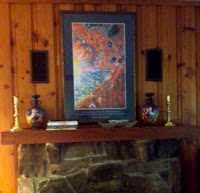When I was in California a few weeks ago, my son-in-law
talked with me about a possible business venture he wanted to launch—a food
truck. However, he cited obstacles like food and vendor licenses, health codes
to maintain, and he couldn't decide on a specialty he wanted to offer beyond
barbecue, a la Cajun style, which he
cooked for us while we were in Palmdale.
In talking with him, I realized that I had little knowledge
of the food truck industry, but after a bit of research, I was surprised to
find that food trucks serve 2.5 billion people in the U.S. every day. They
serve food on college campuses, at farmer's markets, military bases, sports
events, carnivals, and even at construction sites—any place where customers want
a quick, tasty meal for a reasonable price.
The food truck's present popularity stems from an economic
crisis in which experienced chefs lost their jobs and found that preparing and
selling specialties from a small truck could be done with low overhead. The
demand for these food wagons burgeoned, and today they can be found on the
streets of large cities like New York City and Los Angeles, and in small
towns throughout the country. Many of them offer gourmet dishes where folks can
taste exotic food, reasonably priced, during a rushed lunch hour.
Here on The Mountain at Sewanee, Tennessee, the Crescent Cafe food truck has gained popularity among vegans and food enthusiasts who
just want to taste appetizing, healthy fare. The Crescent sells food from a
small window of a refurbished, flower-and-bird painted, 1960's RV from Thursday - Sunday
every week from 11 a.m. - 3 p.m. and offers a menu of smoothies, wraps, salads,
vegan meals, and other specialties. Joan Thomas, who is proprietor of
Mooney's Emporium, owns this food truck. Mooney's is a shop in front of the
Crescent that stocks organic products, fresh local produce, gardening and
knitting supplies, antiques, and art. The chef for the Crescent Cafe, Carole Manganaro, bases her menus on food that is available and in season.
We ate lunch there today and enjoyed a variation of Manganaro's Coconut Carrot Ginger Soup, described as "a sweet and mildly spicy blend of pureed California carrots, hand-peeled ginger with a touch of coconut milk." Curry and other Eastern seasonings had been added to the mix. Add a spinach tortilla wrap filled with Japanese-Inspired Tempeh Salad, and I couldn't eat it all, but I did drink the lagniappe of Buddha Berry Bliss made of organic strawberries, organic bananas, almond milk, organic dates, protein powder, and organic lemon.
 |
| Chef Manganaro |
Chef Manganaro, a native of Wisconsin who says she has been cooking all of her life, has a background in Wildlife Conservation and Rehabilitation, and has lived in Marin, California, Colorado Springs, Colorado, and Belize where she was Clinic Manager for a wildlife bird rehab center before moving to Monteagle six years ago. She was a chef at St. Mary's Conference Center for four years and just celebrated her first year at the Crescent Cafe. "My philosophy is that we can go around the world with food," she says. "We don't have to stick to one genre to have good cuisine." After tasting her fare, we agree that she has eclectic taste in food and plan to return soon for one of her exotic smoothies—maybe the Cocoa Loco made with cocoa, organic peanut butter, organic banana, organic dates and almond milk!
Hikers of the Mt. Goat Trail enjoy the varied menu at the
Crescent, and one reviewer especially praises the juice named after Jane Goodall, the "Goodall," which contains a "sweet and bold blend of kale/apple/parsley/ginger/lemon." Another juice item is the "Beet-rix Potter," a blend of apple/beet/carrot/celery/lemon/mint.
Hikers also enjoy the special misting station Joan has
installed at Mooney's—a place for them to cool off after making the round trip trek
from Mooney's to the trailhead at Sewanee or the shorter distance between
Mooney's and St. Andrews Episcopal School. Following the misting, hikers can
enjoy a juice or meal at the Crescent Cafe.
Besides being a colorful landmark, the Crescent Cafe is a
food truck that should inspire any chef to join in the current movement to sell
good food via truck, mobile or otherwise. Patrons can eat at outdoor picnic tables,
or in case of rain, on the screened back porch of Mooney's, which is where we settled because of the inclement weather. Manganaro also prepares "take-outs."
Note: The Crescent Cafe rated five stars on YELP. And I'd give it even one more!
Photographs by Victoria I. Sullivan



















